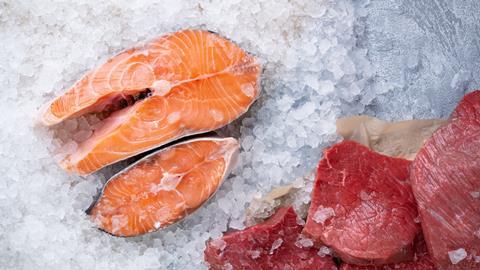In 1594, Gray’s Inn Hall hosted the first performance of Shakespeare’s Comedy of Errors.
The Hall (rebuilt after wartime bombing) can still be found in South Square, Gray’s Inn, a peaceful and secluded space it shares with a statue of Sir Francis Bacon (1561–1626). I assume the juxtaposition is coincidental since the theory that Bacon was the true author of Shakespeare’s plays is now largely discredited. He was in fact an eminent lawyer, statesman and pioneer of scientific thought who had lived and studied in Gray’s Inn. It does appear, however, that at the very end of his life he became an unacknowledged martyr in the cause of food microbiology.
At the time of his death in 1626, Bacon was 5 years into an enforced retirement following charges of taking bribes from litigants, an accusation he admitted though he defended himself by denying that the bribes had ever influenced his decisions. On a cold April day he was near Highgate Hill on a coach ride with the King’s physician, Dr Witherborne, there was snow on the ground and, according to John Aubrey, writing in Brief Lives 50 years later, Bacon wondered ‘why flesh might not be preserved in snow as in salt. They were resolved they would try the experiment…’
To this end, they bought a hen from a woman living nearby, who killed and gutted it and Bacon helped stuff the carcass with snow. According to Aubrey, ‘The snow so chilled him that he immediately fell so extremely ill that he could not return to his lodgings’ and he was taken to the Earl of Arundel’s house nearby where he was put in a damp, unaired bed in which he died of pneumonia 2–3 days later.
Understandably in view of this turn of events, there seems to be no record of how the experiment turned out, but what is perhaps surprising is that they considered it necessary to perform in the first place. It seems that in this country we may have been a little late to the party; the beneficial effect of low temperature on the keeping quality of perishable foods had been widely known and used since antiquity by inhabitants of colder climes – two of many examples being the transportation of fish from northern Europe to Rome, packed in ice and wrapped in insulating furs, and the traditional production of freeze-dried potatoes, chuño, in Peru. These practices were based on empirical observations; we now know that low-temperature preservation operates largely through its effect on a product’s microflora – slowing or arresting its growth. Chill conditions allow only the relatively slow growth of psychrotrophic and psychrophilic microorganisms, which eventually dominate and determine the type of spoilage seen. Freezing stops all microbial growth by a combination of temperature and reduced water activity.
The main obstacle to wider use of low-temperature preservation was its dependence on natural ice. In areas where it was sparingly available, the benefits were largely enjoyed by the wealthy who could store ice throughout the year in the must-have accessory of the time, a subterranean ice house. In England these were introduced from around 1660 and by the 18th century had become a common feature of grand country houses. An early commercial ice store in London was rediscovered in 2018 under Park Crescent, a Nash terrace south of Regent’s Park. Built around 1780, this brick-lined, egg-shaped excavation, 7.5 metres wide and 9.5 metres deep, was found just 8 metres from the tunnels of the Jubilee Line. Initially it stocked locally sourced ice but following a mild winter in 1822 the owner, William Leftwich, began to import ice from the frozen lakes of Norway, part of a profitable international trade in natural ice that reached its peak in the 19th century.
It wasn’t until the 1830s that ice-making machines began to be patented, based on the compression/expansion of air or volatile liquids such as ether or ammonia. The trade in fresh meat stood to gain from this development. Meat was considerably cheaper in Australia or Argentina but its transport to Europe required reliable mechanical refrigeration plant on ships. This exercised the energies of a number of engineers but a solution of the practical difficulties was finally demonstrated by two Frenchmen, Tellier and Carré, who successfully shipped cargoes of frozen meat between France and South America in 1876–77.
Previously, fresh meat had only been available close to slaughter and was expensive, particularly in large centres like London. Cattle were driven into the city to markets such as Smithfield, and traces remain in the name of Cowcross Street and on Liverpool Road, Islington where raised pavements were built to separate human and bovine commuters. But I imagine that the denizens of now expensive residences in nearby Lonsdale Square are pleased they no longer have to look out on to cattle-holding pens.
The disagreeable sights, sounds and smells associated with the driving, slaughter and butchering of large numbers of animals in the close confines of Smithfield made for a particularly unpleasant ambience. In 1855 it became a market for cut meat only, and was rebuilt in 1868 to include an underground railway link to mainline railway stations.
In the following decade, Smithfield began to acquire the cold storage facilities needed to handle increasing imports of chilled and frozen meat. The cold stores also supported scientific research in the form of a small, post-World War II branch laboratory of the Low Temperature Research Station (a distant antecedent of the Quadram Institute). A little earlier, in 1942, one meat store ‘five floors underground’ housed a military project in which a young Max Perutz helped develop a secret new material ‘pykrete’, a frozen suspension of wood pulp in water, suitable for building large floating airstrips. It was never used but fortunately, unlike poor Francis Bacon, Perutz survived the cold (possibly due to an electrically heated aviator’s suit he wore) and went on to win the Nobel Prize for Chemistry in 1962 for work on the structure of globular proteins.








No comments yet